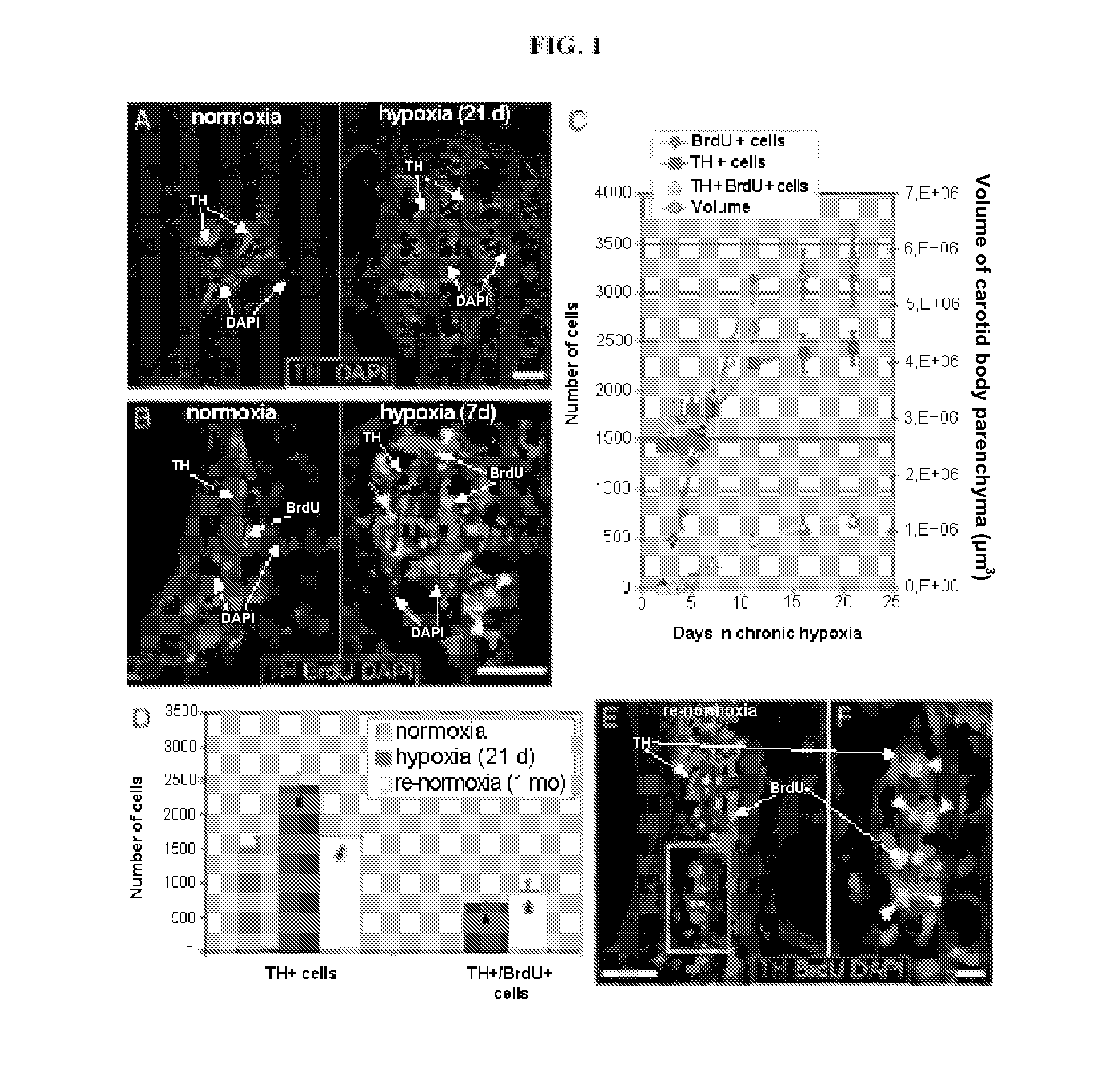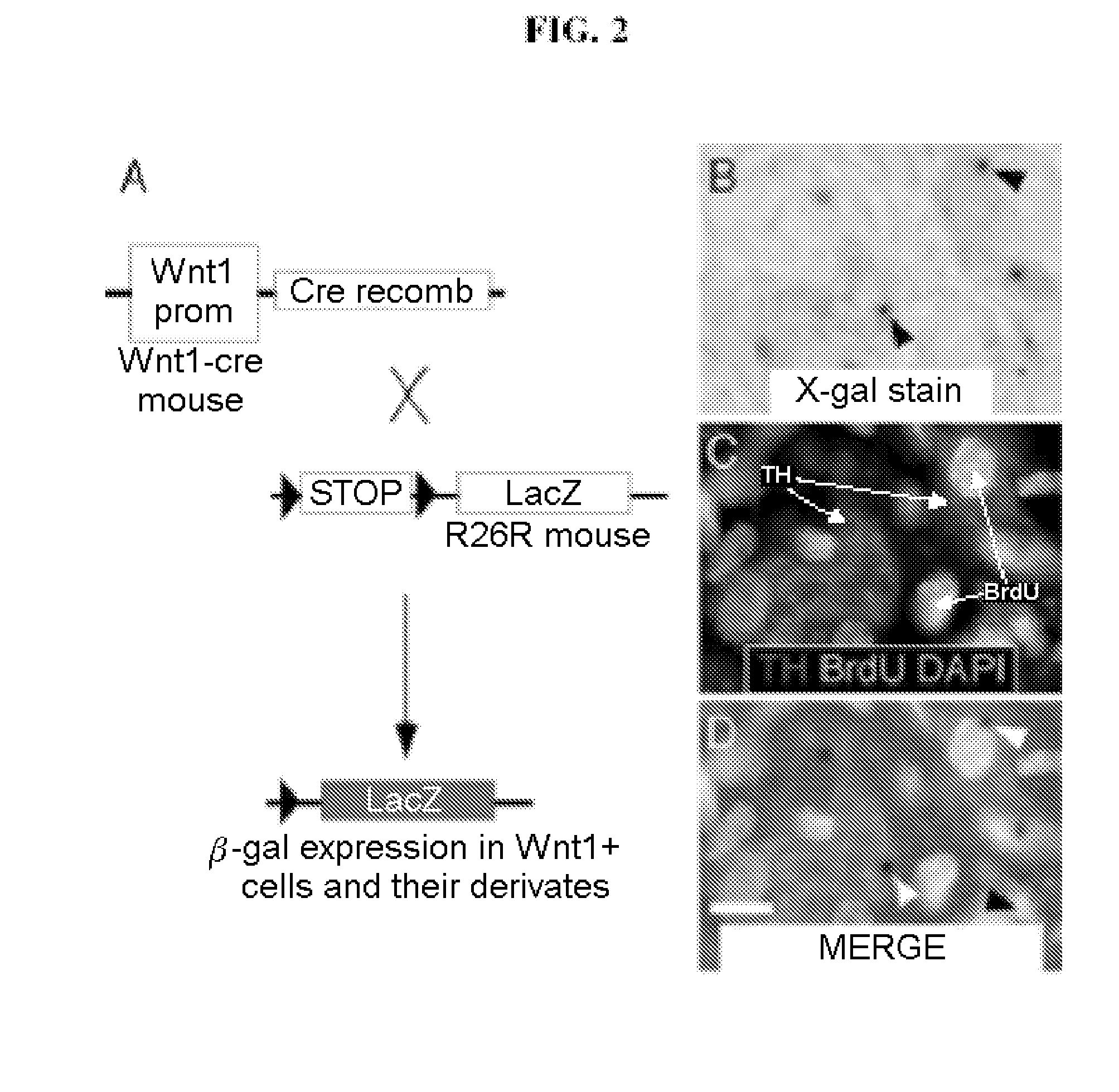Stem cells derived from the carotid body and uses thereof
a stem cell and carotid body technology, applied in the field of stem cells derived from the carotid body isolating and characterization, to achieve the effect of improving the treatment methodology and reducing damag
- Summary
- Abstract
- Description
- Claims
- Application Information
AI Technical Summary
Benefits of technology
Problems solved by technology
Method used
Image
Examples
example 1
Induction of Growth of the Carotid Body by Hypoxia and Generation of New Glomus Cells Derived from the Neural Crest
[0189]Exposure of wild-type C57BL / 6 mice to hypoxia (10% O2) in an isobaric atmosphere for 3 weeks induced an increase in size of the carotid body of approximately 2 to 3 times relative to the initial size, owing to dilatation and multiplication of blood vessels, as well as expansion of the parenchyma, with an increase in the number of TH+ glomus cells (positive for tyrosine hydroxylase) (FIG. 1A).
[0190]For analysis of the proliferation and formation of new glomus cells, the C57BL / 6 mice were treated with BrdU and were then kept for several days in a normoxic (21% O2) or hypoxic (10% O2) environment. No TH+ and BrdU+ cells were observed in the normoxic animals, indicating absence of proliferation (FIG. 1B, left). In contrast, after some days in hypoxia, even before growth of the CB was apparent, numerous TH+ and BrdU+ cells were observed (arrows in FIG. 1B right), indic...
example 2
Identification of Self-Renewing and Pluripotent Stem Cells of the Carotid Body
[0193]For identification of the precursors that give rise to the glomus cells in adult rodents exposed to hypoxia, the carotid bodies of young Wistar rats (>P20) were dispersed enzymatically and the cells were plated in neural crest (NC) culture media that contained bFGF, IGF-I and EGF (Morrison et al., 1999, Cell 96, 737-749). Using culture plates treated for non-adhesion, growth was induced in conditions of flotation and neurospheres were thus obtained. Clonogenic proliferation was stimulated by culture of the cells in moderate hypoxia (3% O2) (Morrison et al., 2000, J Neurosci 20, 7370-7376), a condition that mimics the stimulation by hypoxia of the growth of the CB in vivo.
[0194]In these experiments, 1.04±0.4% (n=6 preparations) of the cells plated gave rise to neurospheres (FIG. 3A). After 10 days in culture the diameter of the neurospheres was 85±34 micrometres (n=112), a value comparable to that des...
example 3
The Sustentacular Cells of Glial Type are the Stem Cells of the CB
[0199]Until now, it has always been thought that in certain circumstances the glomus cells are capable of entering a mitotic cycle (Nurse and Vollmer, 1997 Dev Biol 184, 197-206; Wang and Bisgard, 2002 Microsc Res Tech 59, 168-177). However, it is well established that the TH+ glomus cells can, after dissociation, be maintained in culture for several days (López-Barneo et al., 1988 Science 241, 580-582; Villadiego et al., 2005 J Neurosci 25, 4091-4098). To verify whether proliferation of the glomus cells gave rise to the CB neurospheres, an immunocytochemical analysis was carried out in different stages of formation of neurospheres (FIG. 4A). Initially, the neurospheres were small and were formed by groups of TH−, nestin+ and other nestin− cells. This stage is soon followed by the appearance of small germinal nuclei (protrusions) with some TH+ cells at the periphery of the growing neurospheres. The number of TH+ cells...
PUM
| Property | Measurement | Unit |
|---|---|---|
| partial pressure | aaaaa | aaaaa |
| pressure | aaaaa | aaaaa |
| concentration | aaaaa | aaaaa |
Abstract
Description
Claims
Application Information
 Login to View More
Login to View More - R&D
- Intellectual Property
- Life Sciences
- Materials
- Tech Scout
- Unparalleled Data Quality
- Higher Quality Content
- 60% Fewer Hallucinations
Browse by: Latest US Patents, China's latest patents, Technical Efficacy Thesaurus, Application Domain, Technology Topic, Popular Technical Reports.
© 2025 PatSnap. All rights reserved.Legal|Privacy policy|Modern Slavery Act Transparency Statement|Sitemap|About US| Contact US: help@patsnap.com



